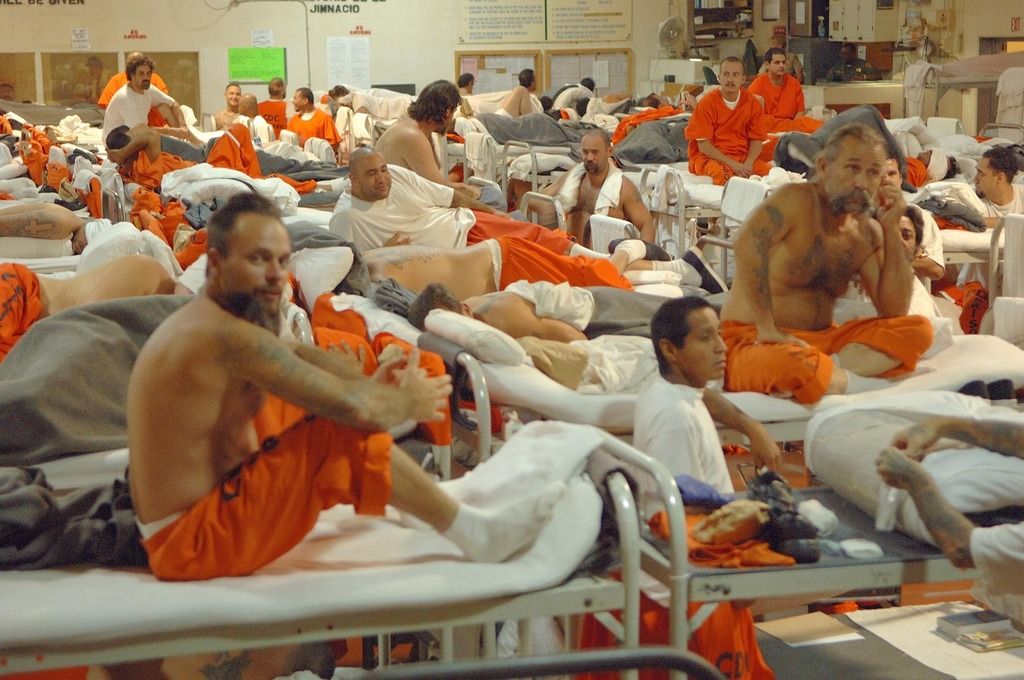We are pleased to announce that as of March 4, 2025, an updated Rich Text Editor has been introduced in the MyFitnessPal Community. To learn more about the changes, please click here. We look forward to sharing this new feature with you!
If the food industry is the "apparent" issue for obesity and health issues....
Replies
-
Lol, it doesn't work that way. If you're in surplus, you gain weight (overeat). If you're in deficit you lose weight (undereat). If you maintain, you don't gain or lose. Believe it or not, most of them probably don't work out any more than the average gym rat and with less equipment to boot. They do other things like watch TV, play cards, sit and BS with each other, etc._whatsherface wrote: »_incogNEATo_ wrote: »_whatsherface wrote: »
Lol, lots of times that "Kosher" item is a pickle.asflatasapancake wrote: »Ok. Devil's advocate. If the food is so bad, perhaps they are not eating as much because it sucks. Are they allowed to eat as much as they want or is there a limit? And perhaps they are moving around enough to offset their calorie intake. I've never been to prison, but do they make license plates and do manual labor type things there? I wonder what the percentage is of inmates that use a weight room or exercise room? I don't know.
Portion controlled food, not all you can eat (although if you have the reputation I suppose you could technically eat others food).
A.C.E. Certified Personal and Group Fitness Trainer
IDEA Fitness member
Kickboxing Certified Instructor
Been in fitness for 30 years and have studied kinesiology and nutrition
That doesn't seem like a lot of food to me. The calorie intake does not seem great either. So most of these inmates are probably eating AT or UNDER their calorie allowance to maintain or gain weight. Also, inmates have a LOT of extra time. If they're not out in the yard exercising, they're in their cells exercising. They have all the time in the world so exercise. Just my thoughts.
That's the WHOLE point.
I guess my point was even if they are over eating, most of them work out hours and hours and hours a day because they have nothing better to do with their time which is why you don't see a lot of obesity.
A.C.E. Certified Personal and Group Fitness Trainer
IDEA Fitness member
Kickboxing Certified Instructor
Been in fitness for 30 years and have studied kinesiology and nutrition
0 -
You need a new carrier. I saw my doc the same day when I called for an ankle issue (Kaiser). I made an eye appointment the same day for my DD 2 months ago to get prescription for glasses. Urgent care costs me $15 dollars. And I got to choose my HOT doctor.HumboldtFred wrote: »I know that comparatively inmates in prison have more food given to them than is required to maintain weight.
I pay 800 bucks a month and my agency pays another 1200 for my medical insurance. When I go to the doc, I pay 20 bucks, when I go to the hospital ER I pay 50 bucks. I pay the first 3500 bucks of major medical out of pocket. I wait 6-12 weeks for a DR appointment since Obama-care destroyed the system.
Inmates pay three bucks and are seen within 3 days. They have it better than me.
AB 109 shifted tens of thousands of inmates back into county jails emptying the prisons and making access more local and more attentive.
Prop 47 turned tens of thousands back onto the streets as low level offenders.
http://mydoctor.kaiserpermanente.org/ncal/provider/nalinirajagopal/about/professional?professional=aboutme.xml&ctab=About Me&cstab=Professional
A.C.E. Certified Personal and Group Fitness Trainer
IDEA Fitness member
Kickboxing Certified Instructor
Been in fitness for 30 years and have studied kinesiology and nutrition
0 -
So, accountability is what you're saying. I am responsible for how much and of what I eat. I am responsible for the amount of activity I take part in. I am responsible for how I treat my own body.
I can change myself?!
You're also saying that OTHER PEOPLE are responsible for their OWN ACTIONS, up to and including WHAT THEY EAT, HOW MUCH THEY EAT, and WHETHER OR NOT THEY EXERCISE?! Mind BLOWN
Mind BLOWN  0
0 -
With an average of about $3 per day per inmate, would you really expect decent quality food?Commander_Keen wrote: »
Where is the article that proves your point?Then why aren't incarcerated people having the same issues?
The prison system serves the lowest quality food. Processed, low grade, fatty, sodium filled, and HFCS injected. ALL the time. And yet with an average 5-15 year incarceration for most inmates, obesity statistics aren't that of the general population.
Food of course is restricted to 3 meals a day. It's not a buffet, so it's portioned out. They aren't exercising all the time to burn off the calories. They don't have daily health care. And there's lots of smoking to boot. In fact, they aren't likely meeting nutritional values essentially, so it's expected that they have chronic health issues. So why aren't these inmates dying off faster with all these issues? A prisoner is much more likely to die of violence in prison, rather than from the "bad" food they are subjected to, yet health officials and some "natural" advocates are claiming that the food industry is the culprit to the obesity epidemic.
Point is that if "bad" food is REALLY the issue for being overweight and obesity and really killing us off, then the same results should be reflected in the prison population. And it's not.
Obesity and weight issues are a DIRECT issue of intake/output. Get that under control and you'll more than likely reduce you risk of health issues.
A.C.E. Certified Personal and Group Fitness Trainer
IDEA Fitness member
Kickboxing Certified Instructor
Been in fitness for 30 years and have studied kinesiology and nutrition
http://www.takepart.com/article/2013/11/11/lousy-state-american-prison-food
http://www.bing.com/videos/search?q=prison+inmate+food+is+low+quality&qpvt=prison+inmate+food+is+low+quality&FORM=VDRE#view=detail&mid=F1130BAF14437D5085F0F1130BAF14437D5085F0
http://www.inmate.com/prison-articles/prison-chow-time.htm
http://www.1union1.com/what_inmates_eat.htm
http://www.sfgate.com/bayarea/article/Jail-food-better-Not-to-inmates-Inmates-bark-2736434.php
A.C.E. Certified Personal and Group Fitness Trainer
IDEA Fitness member
Kickboxing Certified Instructor
Been in fitness for 30 years and have studied kinesiology and nutrition 0
0 -
http://nypost.com/2015/04/28/meet-the-prisoner-who-murdered-killer-cannibal-jeffrey-dahmer/
Boom! No more weight room because VIOLENCE TO THE FACE!
Is it wrong that I laughed? Like REALLY hard?
Is it not hilarious that he died basically the same way he killed his first victim?0 -
Or you could just follow the advice and intuitive eat and just do "clean" eating and never get fat............because "bad" food will always make you fat.lilaclovebird wrote: »So, accountability is what you're saying. I am responsible for how much and of what I eat. I am responsible for the amount of activity I take part in. I am responsible for how I treat my own body.
I can change myself?!
You're also saying that OTHER PEOPLE are responsible for their OWN ACTIONS, up to and including WHAT THEY EAT, HOW MUCH THEY EAT, and WHETHER OR NOT THEY EXERCISE?! Mind BLOWN
Mind BLOWN 

A.C.E. Certified Personal and Group Fitness Trainer
IDEA Fitness member
Kickboxing Certified Instructor
Been in fitness for 30 years and have studied kinesiology and nutrition
0 -
Obesity is an epidemic and there are several reasons why. Lack of physical activity is one, past generation typically had jobs that required more physical labor such as farm or factory work.
going back far enough there were no cars, people walked, rode horses, or rode bicycles to get around
Portion size is probably probably the biggest contribution to obesity. People simply did not eat the massive amounts of food we do now. For my generation a serving of soda is at least 12 oz but typically more. For my parents and grandparents a serving of soda was 8oz.
I believe processed food is a factor in the obesity epidemic, processed food started appearing more during WWII, but even then and at least for sometime after it was not stuff people ate everyday. People used to buy fresh meat, canned and or fresh veggies and cooked from scratch, not tv dinners, frozen pizza, hamburger helper, and takeout. People ate more whole grains, and more vegetables, etc.
Processed foods often have large amount of added sodium, fat, sugar, and other nasty stuff.
There are plenty of empty calorie foods that have little nutritional value, they are cheap, easy to find, and require little to no preparation.
Gen X and Millenials have been raised on processed food that is heavily marketed to kids and teens. Not all parents care what their children eat. I've known people who had parents that never cooked and literally only ate fast food and processed food. For people who have been raised in such a manner it is a hard cycle to break, but it can be done.
There are many, many things that have contributed to obesity. Personally I don't like seeing obesity glorified, just because it's the norm doesn't mean it right. Life expectancy is set to decrease, there are is a plethora of health problems of health problems associated with it.
For some, and by some I mean a small percentage of people their weight issues are the result of an underlying medical condition. Sometimes there are underlying mental health issues that contribute to overeating.
Portion control, diet, exercise, and willpower aren't easy. It's easy to give up, not try, and eat whatever. For people with a large amount of weight to lose it takes time to see results and people often get discouraged and stop. It can take months, even years for an obese or super obese person to reach their goal weight and it takes massive dedication to stick with it. After the goal weight is reached, one has to stick with proper diet and exercise.0 -
I am dutch... I blame myself tooasflatasapancake wrote: »I still blame cellphones, reality tv, and the Dutch.
0 -
As someone who has been in the system, and not ashamed of it at all, let me tell you how my days went.
Got up at 5:30am, waited in day room, served breakfast
6:30-7:30 weight room/yard time (one or the other, never both)
7:30-Noon day room where I played cards, watched tv, used the phone and walked up and down the stairs our the short hall for something to do and for exercise
Noon Lunch
12:30-5 Same as 7:30-noon
5 dinner
5:30-9 same as 7:30-Noon
9-10 Put on my personal radio and jogged in place in my cell
10:30pm Cleaned the block (Trustee)
11:30pm-5:30am sleep
Our meals were very small, mostly bread and pasta based, no junk food unless you had commissary, which I did, and even then I ate very little of it except when I was really hungry from not liking what I was served for one meal or another. I lost 30lbs while in there. Why? No soda, fast food, food that was high in anything more than carbs, no meats....among other things. It's not hard to loose weight in jail/prison, a lot of people do because like me, they worked out all the time for lack of anything else to do. Youll find that people will turn to exercise with little else to help keep them sane.0 -
man I have been poor for way way too long, cuz that food seems acceptable to me. Similar to my food on a regular day.0
-
Whoops.
Failure of primary analysis.
Consequences of High Incarceration Rate and High Obesity Prevalence on the Prison System
Author(s): Meaghan A. Leddy, M.A. ; Jay Schulkin, Ph.D. ; Michael L. Power, Ph.D.
Journal: Journal of Correctional Health Care Volume:15 Issue:4 Dated:October 2009 Pages:318 to 327
Date Published: 10/2009
Page Count: 10
Annotation: This study explored the prevalence of obesity in prison.
The evidence suggests that the prevalence of obesity in a prison is associated with the prevalence in the region; that long-term prison sentences are associated with weight gain; and that the effects of weight gain during incarceration on health and life after release warrants preventive care. Obesity and related disorders have significant effects on health care in the United States. With the increasing overweight and obesity rates in the United States, logistical and financial issues arise in the correctional system regarding the provision of medical care, the housing and transportation of inmates, and the safety of employees. As in general society, alterations will be required of the prison system’s basic infrastructure, not exclusive to the health system. The inclusion of screening and preventive care services relevant to obesity and obesity-related disorders appears to be both low and variable in the United States prison system, when compared to screening and preventive services for communicable diseases. Communicable diseases pose a threat to various individuals, whereas cardiovascular disease is a threat only to those afflicted; however, there is an ethical requirement to provide treatment for these chronic diseases. Even as simple a statistic as body mass index (BMI) is not being calculated and recorded on a consistent basis. This failure represents a lost opportunity to collect data on obesity and its associated consequences in prisons, data that could inform decisions regarding future health care needs and budgets. Figures, tables, and references0 -
Bolded makes sense since someone getting incarcerated in say the South East US, more than likely CAME in obese. It doesn't say they got in the prison and got obese. CICO still prevails because you know as well as I do, if they are consuming 2500 calories a day versus the 5000 or more when they were free, they ain't gonna stay obese.EvgeniZyntx wrote: »Whoops.
Failure of primary analysis.
Consequences of High Incarceration Rate and High Obesity Prevalence on the Prison System
Author(s): Meaghan A. Leddy, M.A. ; Jay Schulkin, Ph.D. ; Michael L. Power, Ph.D.
Journal: Journal of Correctional Health Care Volume:15 Issue:4 Dated:October 2009 Pages:318 to 327
Date Published: 10/2009
Page Count: 10
Annotation: This study explored the prevalence of obesity in prison.
The evidence suggests that the prevalence of obesity in a prison is associated with the prevalence in the region; that long-term prison sentences are associated with weight gain; and that the effects of weight gain during incarceration on health and life after release warrants preventive care. Obesity and related disorders have significant effects on health care in the United States. With the increasing overweight and obesity rates in the United States, logistical and financial issues arise in the correctional system regarding the provision of medical care, the housing and transportation of inmates, and the safety of employees. As in general society, alterations will be required of the prison system’s basic infrastructure, not exclusive to the health system. The inclusion of screening and preventive care services relevant to obesity and obesity-related disorders appears to be both low and variable in the United States prison system, when compared to screening and preventive services for communicable diseases. Communicable diseases pose a threat to various individuals, whereas cardiovascular disease is a threat only to those afflicted; however, there is an ethical requirement to provide treatment for these chronic diseases. Even as simple a statistic as body mass index (BMI) is not being calculated and recorded on a consistent basis. This failure represents a lost opportunity to collect data on obesity and its associated consequences in prisons, data that could inform decisions regarding future health care needs and budgets. Figures, tables, and references
Incidentally, this study is the only study I found on "prevalence" of obesity. It's repeated several times when searched. Here's the counter to it:
What I have noticed though is that women may be getting more obese due to being served the same amount of calories that their males counterparts receive (2500-3500 calories per day).FINDINGS:
31 eligible studies were reported in 29 publications, including more than 60,000 prisoners in 884 institutions in 15 countries. Male prisoners were less likely to be obese than males in the general population (prevalence ratios ranged from 0·33 to 0·87) in all but one study (1·02, 0·92-1·07), whereas female prisoners were more likely to be obese than non-imprisoned women in the USA (1·18, 1·08-1·30) and Australia (prevalence ratios ranged from 1·15 to 1·20). Australian prisoners were more likely to achieve sufficient activity levels than the general population compared with prisoners in the UK (prevalence ratio 1·19, 95% CI 1·04-1·37, for women in Australia in 2009 vs 0·32, 0·21-0·47, for women in the UK; prevalence ratios ranged from 1·37 to 1·59 for men in Australia vs 0·71, 0·34-0·78, for men in the UK). Female mean energy intake exceeded recommended levels and sodium intake was about two to three times the recommended intake for all prisoners.
http://www.ncbi.nlm.nih.gov/pubmed/22521520
A.C.E. Certified Personal and Group Fitness Trainer
IDEA Fitness member
Kickboxing Certified Instructor
Been in fitness for 30 years and have studied kinesiology and nutrition
0 -
Bolded makes sense since someone getting incarcerated in say the South East US, more than likely CAME in obese. It doesn't say they got in the prison and got obese. CICO still prevails because you know as well as I do, if they are consuming 2500 calories a day versus the 5000 or more when they were free, they ain't gonna stay obese.EvgeniZyntx wrote: »Whoops.
Failure of primary analysis.
Consequences of High Incarceration Rate and High Obesity Prevalence on the Prison System
Author(s): Meaghan A. Leddy, M.A. ; Jay Schulkin, Ph.D. ; Michael L. Power, Ph.D.
Journal: Journal of Correctional Health Care Volume:15 Issue:4 Dated:October 2009 Pages:318 to 327
Date Published: 10/2009
Page Count: 10
Annotation: This study explored the prevalence of obesity in prison.
The evidence suggests that the prevalence of obesity in a prison is associated with the prevalence in the region; that long-term prison sentences are associated with weight gain; and that the effects of weight gain during incarceration on health and life after release warrants preventive care. Obesity and related disorders have significant effects on health care in the United States. With the increasing overweight and obesity rates in the United States, logistical and financial issues arise in the correctional system regarding the provision of medical care, the housing and transportation of inmates, and the safety of employees. As in general society, alterations will be required of the prison system’s basic infrastructure, not exclusive to the health system. The inclusion of screening and preventive care services relevant to obesity and obesity-related disorders appears to be both low and variable in the United States prison system, when compared to screening and preventive services for communicable diseases. Communicable diseases pose a threat to various individuals, whereas cardiovascular disease is a threat only to those afflicted; however, there is an ethical requirement to provide treatment for these chronic diseases. Even as simple a statistic as body mass index (BMI) is not being calculated and recorded on a consistent basis. This failure represents a lost opportunity to collect data on obesity and its associated consequences in prisons, data that could inform decisions regarding future health care needs and budgets. Figures, tables, and references
Incidentally, this study is the only study I found on "prevalence" of obesity. It's repeated several times when searched. Here's the counter to it:
What I have noticed though is that women may be getting more obese due to being served the same amount of calories that their males counterparts receive (2500-3500 calories per day).FINDINGS:
31 eligible studies were reported in 29 publications, including more than 60,000 prisoners in 884 institutions in 15 countries. Male prisoners were less likely to be obese than males in the general population (prevalence ratios ranged from 0·33 to 0·87) in all but one study (1·02, 0·92-1·07), whereas female prisoners were more likely to be obese than non-imprisoned women in the USA (1·18, 1·08-1·30) and Australia (prevalence ratios ranged from 1·15 to 1·20). Australian prisoners were more likely to achieve sufficient activity levels than the general population compared with prisoners in the UK (prevalence ratio 1·19, 95% CI 1·04-1·37, for women in Australia in 2009 vs 0·32, 0·21-0·47, for women in the UK; prevalence ratios ranged from 1·37 to 1·59 for men in Australia vs 0·71, 0·34-0·78, for men in the UK). Female mean energy intake exceeded recommended levels and sodium intake was about two to three times the recommended intake for all prisoners.
http://www.ncbi.nlm.nih.gov/pubmed/22521520
A.C.E. Certified Personal and Group Fitness Trainer
IDEA Fitness member
Kickboxing Certified Instructor
Been in fitness for 30 years and have studied kinesiology and nutrition
Your study is for incarceration populations all over the world, which isn't necessarily following the meal plan you outlined in your op. In several places, incarceration meals are better than gen pop meal availability, etc...
The article I posted shows an increase in weight within long term incarceration in the U.S.
Now, whether it's true or not, I really don't know but it questions your original premise that prisoners don't get fat on their diet.
Even the article you posted sows doubt - how are all those women becoming obese in those "lower" calorie meals. Hint - they aren't. So the premise that calories are restricted in prison populations needs to be tossed aside.
The whole obesity in prison as a control experiment is weak because calorie consumed isn't as controlled as you might think (commissary, etc).0 -
Actually original OP questioned about OBESITY in prison system population if "bad" food was actually the culprit. Apparently not since even with inmate pics, you'd be pressed to find a definitive amount of obese inmates walking around (look at pics I posted a few pages back). Getting fat? There is commissary, which ISN'T part of the prison food system, and inmates will buy what's available (which will usually be junk food of some sort). Could they be getting fat from eating Snickers or jars of peanut butter? Who knows, but a calorie count of 2500 calories more than likely will be closer to maintenance than progressive weight gain.EvgeniZyntx wrote: »
Bolded makes sense since someone getting incarcerated in say the South East US, more than likely CAME in obese. It doesn't say they got in the prison and got obese. CICO still prevails because you know as well as I do, if they are consuming 2500 calories a day versus the 5000 or more when they were free, they ain't gonna stay obese.EvgeniZyntx wrote: »Whoops.
Failure of primary analysis.
Consequences of High Incarceration Rate and High Obesity Prevalence on the Prison System
Author(s): Meaghan A. Leddy, M.A. ; Jay Schulkin, Ph.D. ; Michael L. Power, Ph.D.
Journal: Journal of Correctional Health Care Volume:15 Issue:4 Dated:October 2009 Pages:318 to 327
Date Published: 10/2009
Page Count: 10
Annotation: This study explored the prevalence of obesity in prison.
The evidence suggests that the prevalence of obesity in a prison is associated with the prevalence in the region; that long-term prison sentences are associated with weight gain; and that the effects of weight gain during incarceration on health and life after release warrants preventive care. Obesity and related disorders have significant effects on health care in the United States. With the increasing overweight and obesity rates in the United States, logistical and financial issues arise in the correctional system regarding the provision of medical care, the housing and transportation of inmates, and the safety of employees. As in general society, alterations will be required of the prison system’s basic infrastructure, not exclusive to the health system. The inclusion of screening and preventive care services relevant to obesity and obesity-related disorders appears to be both low and variable in the United States prison system, when compared to screening and preventive services for communicable diseases. Communicable diseases pose a threat to various individuals, whereas cardiovascular disease is a threat only to those afflicted; however, there is an ethical requirement to provide treatment for these chronic diseases. Even as simple a statistic as body mass index (BMI) is not being calculated and recorded on a consistent basis. This failure represents a lost opportunity to collect data on obesity and its associated consequences in prisons, data that could inform decisions regarding future health care needs and budgets. Figures, tables, and references
Incidentally, this study is the only study I found on "prevalence" of obesity. It's repeated several times when searched. Here's the counter to it:
What I have noticed though is that women may be getting more obese due to being served the same amount of calories that their males counterparts receive (2500-3500 calories per day).FINDINGS:
31 eligible studies were reported in 29 publications, including more than 60,000 prisoners in 884 institutions in 15 countries. Male prisoners were less likely to be obese than males in the general population (prevalence ratios ranged from 0·33 to 0·87) in all but one study (1·02, 0·92-1·07), whereas female prisoners were more likely to be obese than non-imprisoned women in the USA (1·18, 1·08-1·30) and Australia (prevalence ratios ranged from 1·15 to 1·20). Australian prisoners were more likely to achieve sufficient activity levels than the general population compared with prisoners in the UK (prevalence ratio 1·19, 95% CI 1·04-1·37, for women in Australia in 2009 vs 0·32, 0·21-0·47, for women in the UK; prevalence ratios ranged from 1·37 to 1·59 for men in Australia vs 0·71, 0·34-0·78, for men in the UK). Female mean energy intake exceeded recommended levels and sodium intake was about two to three times the recommended intake for all prisoners.
http://www.ncbi.nlm.nih.gov/pubmed/22521520
A.C.E. Certified Personal and Group Fitness Trainer
IDEA Fitness member
Kickboxing Certified Instructor
Been in fitness for 30 years and have studied kinesiology and nutrition
Your study is for incarceration populations all over the world, which isn't necessarily following the meal plan you outlined in your op. In several places, incarceration meals are better than gen pop meal availability, etc...
The article I posted shows an increase in weight within long term incarceration in the U.S.
Now, whether it's true or not, I really don't know but it questions your original premise that prisoners don't get fat on their diet.
It was mentioned in a previous article a few pages back, that women are likely gaining weight because of consuming the SAME calorie count as a male.Even the article you posted sows doubt - how are all those women becoming obese in those "lower" calorie meals. Hint - they aren't. So the premise that calories are restricted in prison populations needs to be tossed aside.“The evidence suggests that female prisoners are simply supplied with a diet designed for males,” reported the authors of the study (which was led by Dr. Katharine Herbert). “This finding is in accordance with current concerns that prisons are institutions designed by men for men with little concern for the needs of women who form a minority of the global prison population.”
http://blog.crchealth.com/2012/04/26/obesity-behind-bars-researchers-study-diet-exercise-among-prisoners/
While there is access to commissary, etc. the US male prison population doesn't at all resemble the 32% obesity for men in general population. Overweight, maybe.The whole obesity in prison as a control experiment is weak because calorie consumed isn't as controlled as you might think (commissary, etc).
EDIT: I posted the pics in "FED UP" thread. Here they are:



A.C.E. Certified Personal and Group Fitness Trainer
IDEA Fitness member
Kickboxing Certified Instructor
Been in fitness for 30 years and have studied kinesiology and nutrition
0 -
bump0
-
I think that a few pictures don't validate your theory.
The research is scarce.
Volume 2015 (2015), Article ID 532468, 7 pages
http://dx.doi.org/10.1155/2015/532468
Research Article
The Impact of Incarceration on Obesity: Are Prisoners with Chronic Diseases Becoming Overweight and Obese during Their Confinement?
Madison L. Gates1 and Robert K. Bradford2
1Institute of Public and Preventive Health, Georgia Regents University, 1120 15th Street, CJ-2300, Augusta, GA 30912, USA
2Georgia Correctional HealthCare, Georgia Regents University, 1499 Walton Way, HS 3507, Augusta, GA 30912, USA
Received 15 October 2014; Accepted 5 March 2015
Academic Editor: Aron Weller
Copyright © 2015 Madison L. Gates and Robert K. Bradford. This is an open access article distributed under the Creative Commons Attribution License, which permits unrestricted use, distribution, and reproduction in any medium, provided the original work is properly cited.
Abstract
Introduction. The association between incarceration and weight gain, along with the public health impact of former prisoners who are overweight or obese, warrants more investigation to understand the impact of prison life. Studies regarding incarceration’s impact on obesity are too few to support assertions that prisons contribute to obesity and comorbid conditions. This study examined a statewide prison population over several years to determine weight gain. Methods. Objective data for weight, height, and chronic diseases, along with demographics, were extracted from an electronic health record. These data were analyzed statistically to determine changes over time and between groups. Results. As a total population, prisoners not only gained weight, but also reflected the distribution of BMIs for the state. There were differences within the population. Male prisoners gained significantly less weight than females. The population with chronic diseases gained less weight than the population without comorbid conditions. Prisoners with diabetes lost weight while hypertension’s impact was negligible. Conclusion. This study found that weight gain was a problem specifically to females. However, this prison system appears to be providing effective chronic disease management, particularly for prisoners with diabetes and hypertension. Additional research is needed to understand the impact incarceration has on the female population.
So apparently make prisoners are also gaining weight.
And by the numbers...
http://paa2009.princeton.edu/papers/909510 -
And http://societyofcorrectionalphysicians.org/corrdocs/corrdocs-archives/winter-2010/chronic-medical-diseases-among-jail-and-prison-inmates
Findings
What were the most common chronic medical conditions among inmates?
As one would expect, the prevalence of chronic conditions among inmates vary by age, but among 34 to 49 year old men and women in prison, the leading condition was overweight, with a prevalence of 47% (Figure 1). After overweight, the leading medical conditions were:
1) Hypertension (24.7%)
2) Obesity (24.7)
3) Arthritis (23.1%)
4) Asthma (13.9%)
5) Hepatitis (12.9%)
Of the conditions we examined, cancer was reported by 3.1% of 34-49 year olds, and cervical cancer was reported by 6.3% of the women. In this age group, underweight (0.4%), myocardial infarction (0.9%) and angina (0.8%) were the least common conditions.0 -
I think you and I would agree that BMI isn't an effective way to gauge obesity amongst a population of people who carry more lean muscle than the average person. Statistically based on my height and weight, I'm a class 1 obese person (5'7" 200lbs). There are LOTS of jacked guys in prison. And as mentioned, you have to be somewhat physically fit to survive in there. Is it plausible that 24.7% of dudes in prison are muscular?EvgeniZyntx wrote: »And http://societyofcorrectionalphysicians.org/corrdocs/corrdocs-archives/winter-2010/chronic-medical-diseases-among-jail-and-prison-inmates
Findings
What were the most common chronic medical conditions among inmates?
As one would expect, the prevalence of chronic conditions among inmates vary by age, but among 34 to 49 year old men and women in prison, the leading condition was overweight, with a prevalence of 47% (Figure 1). After overweight, the leading medical conditions were:
1) Hypertension (24.7%)
2) Obesity (24.7)
3) Arthritis (23.1%)
4) Asthma (13.9%)
5) Hepatitis (12.9%)
Of the conditions we examined, cancer was reported by 3.1% of 34-49 year olds, and cervical cancer was reported by 6.3% of the women. In this age group, underweight (0.4%), myocardial infarction (0.9%) and angina (0.8%) were the least common conditions.
And yes there isn't a lot of research, so we keep discussing the same study over and over again. But I'll stand by my convictions. Am truly doubting that even with all the low quality food in prison, obesity isn't an issue like it is in general population.
A.C.E. Certified Personal and Group Fitness Trainer
IDEA Fitness member
Kickboxing Certified Instructor
Been in fitness for 30 years and have studied kinesiology and nutrition
0 -
bump0
This discussion has been closed.
Categories
- All Categories
- 1.4M Health, Wellness and Goals
- 394.5K Introduce Yourself
- 44K Getting Started
- 260.5K Health and Weight Loss
- 176.1K Food and Nutrition
- 47.5K Recipes
- 232.7K Fitness and Exercise
- 444 Sleep, Mindfulness and Overall Wellness
- 6.5K Goal: Maintaining Weight
- 8.6K Goal: Gaining Weight and Body Building
- 153.1K Motivation and Support
- 8.1K Challenges
- 1.3K Debate Club
- 96.4K Chit-Chat
- 2.5K Fun and Games
- 4.1K MyFitnessPal Information
- 16 News and Announcements
- 1.3K Feature Suggestions and Ideas
- 2.8K MyFitnessPal Tech Support Questions

![img}]](http://assets3.thrillist.com/v1/image/1148154/size/tmg-slideshow_xl[/img}])





